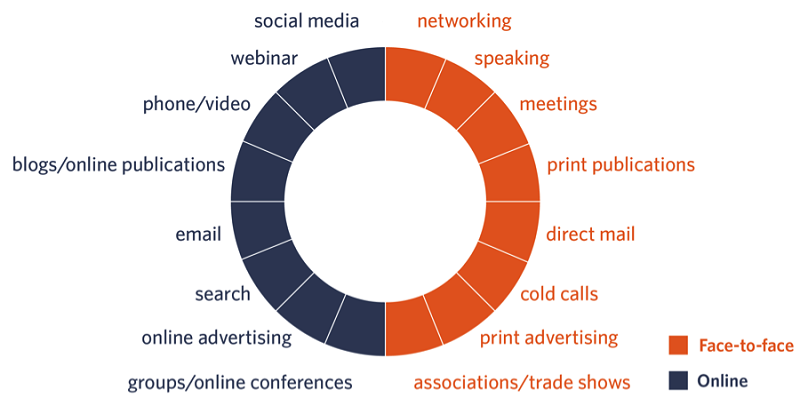The sales techniques are specifically designed strategies to positively influence the buying and selling process, in order to improve the likelihood that the potential customer purchases a product or service from the seller. In practice, we assume that a seller meetings hundred potential customers and can convince to buy ten of them, without the aid of any sales strategy in particular. Thus obtain a rate of closures of 10%. The sales techniques should, in theory, much improve this percentage. The most famous sales techniques are called AIDA and SPIN Selling, which are two initial representatives acronyms applied to action. Do not worry! I’ll explain immediately what they mean: => AIDA stands for…
Awareness
The encounter stage where you have to capture the prospect’s attention. Typically, it lasts very little, often you get with a single sentence. It ‘a very important step because if you do not get the attention of the interlocutor, hardly the meeting will land somewhere …
Interest
It is the meeting stage where you have to try to arouse the interest of potential clients. In this phase, you try to connect its needs, conscious or unconscious; making him feel that with your product or service will solve them. Typically, this phase is characterized by the use, by the seller, of stressing actions that lead to emphasize or exaggerate the problems, to load the prospect of anxiety (anxiety of not being able to solve alone) and interest (on how can out of trouble). I have seen at times to use the phase of stressing in a very marked way, so as to make the situation almost always unrealistic and ending with the seller that you send to hell …
Desire
If you followed the previous two phases in a correct and balanced, the customer is inclined to desire your way out of its problems. The seller must, therefore, accompany the client potential at a location to try to imagine how it will make him his life (or a particular situation / activity) when he will use his product / service. The more the customer will identify in the situation, the greater the desire that will make for your solution, the greater the possibility that in the end he buys from you.
Action
If you are here it in a natural way, that is, without the other person will have and realized you were using sales techniques, then the action, that is, sign the contract (or if you prefer, your wallet ), it will be the normal outcome of the meeting.
However, it is not that because you’ve done the homework to the stage of desire, then the closure will always be positive. Obvious that even at this stage you need to use proper marketing techniques that allow you to bypass some typical objections that the most customer, you before!

The most popular objections are the price, timing, and the absence of the decision maker. Very common techniques to reply to the objections are to be hurried, scarcity, fear, etc. And if you slam in your face further objections, then it is simply because – quite possibly – have not worked well in an earlier stage … => Instead SPIN stands for…
Situation questions
The method consists of four phases in which the seller must put certain set of questions. In the first phase, it is up to those that highlight the current situation of the potential customer.
Problem questions
Is a stage where you make specific questions to bring out the problems and any inconvenience that test the other person. If at this stage works as it should, then you probably answer that you will allow you to understand the customer’s needs.
Implication questions
They are the questions so as to understand what are the potential implications of the prospect’s problems. The stage is almost similar to that of the little desire view ago and, in fact, even in this system you have to do in order to exaggerate the problems and negative effects.
Need-payoff questions
At this late stage, you have to explicitly ask the customer what its problems and its real needs. After that, you shall set the solution or solutions. Often the solutions are not envisaged at the end of the meeting, but in a second meeting that will be fixed to the end of the first, specifically to study the solution.
This sales technique is mainly used by the consultants (especially in the financial sector), which must be given time to study the asset. Or from all the vendors that cannot propose a directly price (such as computer consultants of software companies that are making the estimate in the company for tailor-made programs). Finally, to those who try to pretend to have a wide choice of products and services, but in reality it has only one for all … Regardless of the sales techniques used, whether it is AIDA or SPIN or other less known, some behaviors on how to sell, can reveal more useful. For example, it is always advisable to close a deal with one of the following options …
- Quit putting quickly in practice, it is the best known technique from the sellers, even those who are amateurs know it and is to give a limited time to the other party choice. For example, the most sought is the offer that expires today (or tomorrow at the latest) even though in reality there is no limit. Another method is to say that there are tot pieces limited and we do not know if tomorrow there will be more. In particular this is the rarefaction technique that, properly used, can be useful as a method for quickly (especially if the do not get to buy the solution could arise fear). The problem of this technique is the fact that is so well-known that potential customers know it and therefore has lost most of its original effectiveness.
- Close with a question: This selling technique is used especially in financial consulting and sale of products and services that can make a choice to purchase. For example, in the insurance business could be asked a question like, “we include coverage for damage or vandalism prefer the standard cover?”. Instead, in the sale of IT services, could be offered to the type “application wants that computers are covered by our antivirus total protection or you just what basis?”. In selling products instead demand could be like “the coffee machine you want the white, red or blue?”. In conclusion: to negotiate you have a question with the order to move the potential customer to a closed position. The latter will feel involved in the process and, therefore, will tend to respond implicitly buying the product / service.
- Close with action: This method is used when you see that the customer is already interested in / solutions in your possession. Maybe he already understood the utility, but you are doing mental saws whether or not to buy. At this point you have to try to take it for granted that he can not do without and, a bit hand, usually take a few phrases like “as it is concerned, rather than hydraulic or mechanical press?”. That is, you assume that he either takes it and two or more possible options of a single product / service and then waiting for his choice.
- Close with a logical reasoning: This method is often used by those who sell the method of counseling is to summarize and to outline everything that was said during the meeting, and then present the solution.
- Close confiding a secret: With certain types of customers can be useful to play the part of confidante. If you think a guy a little hesitant and, at the same time, you have the impression that someone who cares particularly be respected (those short old school to which it gives the doctor even if it has the fifth grade), then fill in the secret technique … or you’re just saying that to him because you like or whatever. This will make you feel like a salesman who is keen to make a good impression, informed of the facts and does not pull cans. Obvious that the technique only works with clients of a certain type.
But it does not end there. Independent of the used sales techniques, how close a deal or how you lead, advice that I can give you, and I see that many often disregard, is not to provide free consultations “seasoned” by a final quote! It is a very serious error.
Why not give free consultations?
Because, with the information from the sweat of his brow, and with so much time lost, the potential customer is from another vendor and you do make a better price than yours. The other seller already knows what price do you (thanks to your quote) and will have an easy time making an offer to the downside. Unless you do not have the money itself competitive in the market, one that makes a handful of dollar in less than I’ll ever find! Often the potential customer already knows from the minute you will not buy anything from you, but continues to make targeted questions that confuse the inexperienced interest, in order to make you unbutton and compare what you say with what he says the guy from whom it always provides (so say “lower the price or you change”).
Why not give information?
It should add that in some areas, as it could be advice (legal, tax, commercial, or whatever), provide too much information can haunt you. The customer may, in fact, feeling “full” of information already received. Other times to give too much information the customer sends in paranoia that for too much choice or too many reflections, do not buy anything to avoid mistakes.
Conclusion
To sell it is a real job that NOT be improvised and it is absolutely true that “Sellers are born.” Therefore, if you want to learn how to sell well, it is very important that you frequent a modern and updated marketing course, to teach you how to negotiate through appropriate sales techniques updated to modern times and to the situation.

